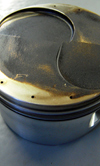It's all about consistency
 For John Force Racing co-crew chiefs Dean ‘Guido’ Antonelli and Ron Douglas, the 2009 Funny Car season has been all about consistency. Include the selection of Venolia pistons in that mix because, as Antonelli points out, “In our current configuration, the pistons are relatively the same on all eight cylinders. They may vary from cylinder to cylinder, depending on the distribution of air coming out of the blower,” he allowed.
For John Force Racing co-crew chiefs Dean ‘Guido’ Antonelli and Ron Douglas, the 2009 Funny Car season has been all about consistency. Include the selection of Venolia pistons in that mix because, as Antonelli points out, “In our current configuration, the pistons are relatively the same on all eight cylinders. They may vary from cylinder to cylinder, depending on the distribution of air coming out of the blower,” he allowed.
If the pair are getting driver Ashley Force-Hood down the track without hurting any parts, they can easily stay with the same piston stagger for well more than one race. “It could be for as many as four races or maybe all year, if it’s friendly,” Antonelli said.
This team “has at our disposal a lot of different compression heights that we can play with,” Douglas noted, “but we try not to change it if it’s working for us, which it is currently.” They are in second place in the Funny Car category’s Countdown to One, with five races to go at this writing.
Inspection of their pistons is all-important for Antonelli and Douglas. “There is a lot that goes into inspection after a run. We are always looking at the piston to see what happened to it on that particular run and also, in our inspection process, we want to make sure that piston is able to make another run so we don’t have a failure,” Douglas said.
“We get a good product from our piston supplier but we don’t leave everything to their end. We inspect the product, measure and go through the pistons when they’re new – just like we do after a run,” he continued. “Nothing gets put in the engine unless it’s stamped ‘A OK’ by our team.”
On average, this team replaces its pistons after three runs, although they can be replaced after a single pass. “Sometimes they’re good for five; it kind of varies, depending on conditions. The pistons we put in for the Friday night runs maybe don’t come back in as good condition as the pistons we use for a hot track run where you don’t have as much fuel and you’re not pulling on it as hard,” Douglas added. “Each run is its own animal.”
“We allow ourselves to run the pistons a bit harder on the night runs,” Antonelli concurred. “We’re not as concerned when we use up a couple more on those runs, but if we are hurting them and we’re going slow, then we’re more concerned. We try not to over-react for testosterone or anything else. If the conditions are there, we’ll stand on it; if they’re not, we’ll make the safe call to go down the track.”
The decision on which piston to use occurs between rounds and that call comes well before engine warm-up. “We’ll go out there and evaluate [conditions] and do what we think we can run. We’ll see what the track looks like and we’ll talk about it,” Douglas said. “I don’t think we need to change that approach.”
“This year we have a master plan to try and get our cars more like we all were a couple of years back so we’re working that way the last five races or so and it seems to be working,” Antonelli said of their operation. “The cars have gotten more similar with the Countdown coming and we’ve fed off one another.”
Written by Anne Proffit.